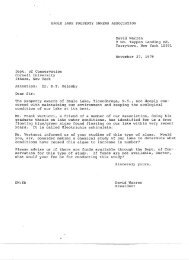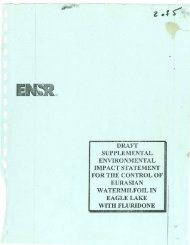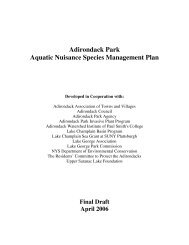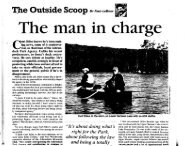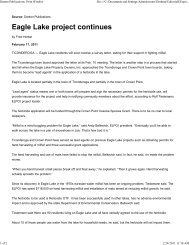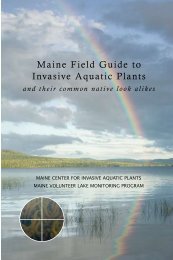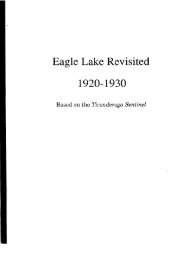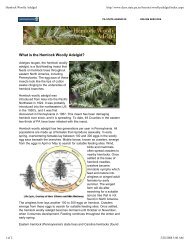Lake Hortonia 2008 - Eagle Lake Property Owner's Inc.
Lake Hortonia 2008 - Eagle Lake Property Owner's Inc.
Lake Hortonia 2008 - Eagle Lake Property Owner's Inc.
Create successful ePaper yourself
Turn your PDF publications into a flip-book with our unique Google optimized e-Paper software.
1 floating species and 2 emergent species in 1999 through 2001 (Getsinger et al. 2002).<br />
Eurasian watermilfoil (Myriophyllum spicatum) populations were first confirmed in 1984 and<br />
reported to be problematic by the mid-1990’s (LHPOA/BPA 1999). Prior to herbicide treatment<br />
in 2000, Myriophyllum spicatum was the most common plant species, present in >54% of survey<br />
points (Getsinger et al. 2002). A second exotic species, Potamogeton crispus (Curly-leaf<br />
Pondweed) was also reported. At the conclusion of post-treatment surveys in August 2001,<br />
frequency of occurrence of Myriophyllum spicatum had been reduced by 85%, with this species<br />
reported in only 6% of survey points. In a pre-treatment survey in August of 2003,<br />
Myriophyllum spicatum was reported in 52% of survey points, comparable to pre-treatment<br />
frequency of occurrence reported in 1999. Following an herbicide treatment in the Spring of<br />
2004, Myriophyllum spicatum had been reduced by 33%, reported in less than 35% of survey<br />
points. Myriophyllum spicatum specimens observed in August of 2004 were generally in poor<br />
condition. An August of 2005 survey reported Myriophyllum spicatum in 2% of survey points.<br />
Spot treatments of the shoreline of <strong>Lake</strong> <strong>Hortonia</strong> with the herbicide Renovate 3 were conducted<br />
in the Spring of 2006 thru <strong>2008</strong> to further reduce Myriophyllum spicatum abundance. Hand and<br />
suction harvesting were also employed in <strong>2008</strong>.<br />
Figure 1. Map of Burr Pond with point intercept survey locations for <strong>2008</strong>.<br />
Species List and Herbarium Specimens. As the lakes were surveyed, the occurrence of each<br />
aquatic plant species observed in the lake was recorded and adequate herbarium specimens were<br />
collected. The herbarium specimens were returned to the Darrin Fresh Water Institute, where<br />
they were pressed, dried, and mounted (Hellquist 1993). A number of species which were<br />
2



